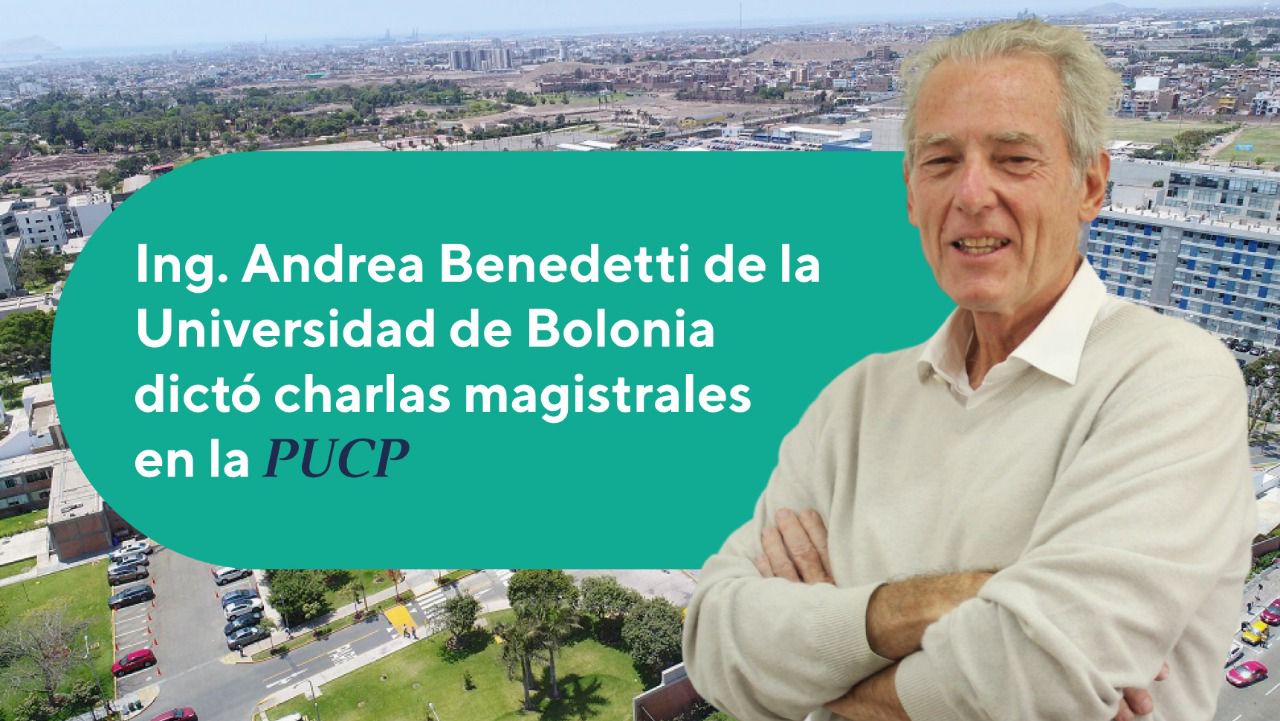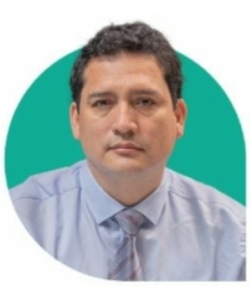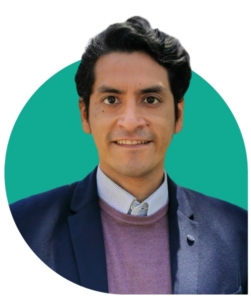
Entre el martes 15 y el jueves 17 de noviembre, Ingeniería PUCP tuvo el agrado de contar con charlas magistrales dictadas por el Ing. Andrea Benedetti, de la Universidad de Bolonia (Italia), gracias a fondos que la Universidad de Bolonia le otorgó al Ing. Benedetti, especialista en ingeniería estructural dinámica y monitoreo estructural.
 “Ha sido un agrado recibir al profesor Andrea Benedetti quien ha impartido un conjunto de clases relacionados con monitoreo estructural. Realmente, ha sido una experiencia muy nutrida de experiencias y prácticas que él ha compartido con nosotros de sus experimentos en puentes en la Universidad de Bolonia y creo que inicia una etapa de colaboración entre ambos programas”.
“Ha sido un agrado recibir al profesor Andrea Benedetti quien ha impartido un conjunto de clases relacionados con monitoreo estructural. Realmente, ha sido una experiencia muy nutrida de experiencias y prácticas que él ha compartido con nosotros de sus experimentos en puentes en la Universidad de Bolonia y creo que inicia una etapa de colaboración entre ambos programas”.
Mg. José Velásquez- docente de la Sección Ingeniería Civil
Esta visita tuvo como propósito realizar una transferencia de conocimiento a los alumnos y docentes de Ingeniería PUCP sobre lo que se está desarrollando en la actualidad en el Departamento de Ingeniería Civil de la Universidad de Bolonia, en temas referentes al monitoreo estructural, dinámica y evaluación de estructuras.

“The theme of the presentation was the study of the methods used in structural health analysis of bridges. That means we want to try to understand what is the damage level of existing structure by using some recordings of the dynamic signals coming from a valuable load acting on those stretchers”.
Ing. Andrea Benedetti
Charlas magistrales del Ing. Andrea Benedetti:
En una jornada que duró tres días seguidos, el profesor visitante expuso presencialmente en la PUCP los siguientes temas:
Relación con el GERDIS-PUCP
En el 2013, el Dr. Nicola Tarque, investigador del Grupo de Gestión de Riesgos de Desastres en Infraestructura Social y Vivienda de Bajo Costo GERDIS- PUCP, realizó un posdoctorado en la Universidad de Bolonia, donde estudió la modelación no lineal de muros de piedra con una modelación simplificada. Los artículos producto de esta investigación fueron expuestos en congresos y publicados en revistas indexadas.
Gracias a la experiencia que el Dr. Tarque obtuvo en este posdoctorado, actualmente se encuentra elaborando una investigación sobre la evaluación numérica y sísmica de muros de piedra inca y preinca, financiada por el Fondo de Apoyo a la Investigación (FAI).

«Es la primera investigación que se está realizando tanto a nivel experimental como numérica para evaluar la capacidad y la estabilidad estructural de los muros incas”
Dr. Nicola Tarque
Hoy en día, ya se ha realizado una evaluación de campo a diversas zonas arqueológicas de Cusco y Puno. También, se han realizado publicaciones indexadas en Scopus y se espera obtener los resultados a inicios o mediados del 2023 con la finalidad de modelar a ciencia cierta la modalidad estructural de otros tipos de muros, como los incas.
Así mismo, el Ing. Benedetti propuso sugerencias sobre la evaluación de la seguridad sísmica de las construcciones inca y preinca, y también la caracterización tipológica de los muros de piedra del Perú.
«The problem is obviously in a lot of millions of buildings there are anyway, a lot of buildings not designed to resist flutings or earthquakes, but we can monitor it and decide what is the minimum level that they must have in order to reduce the number of deaths. Monitoring is very important and what we can do now in the future will certainly be done without huge cost, because censors are costing less and less and techniques are developing and we can monitor even with very simple systems that will cost not so much and therefore we can extend to many buildings», añadió el Ing. Andrea Benedetti.
Para concluir, les compartimos la entrevista completa al Ing. Andrea Benedetti.
What is the theme of the present?
The theme of the presentation was the study of the methods used in structural health analysis of bridges. That means we want to try to understand what is the damage level of the existing structure is using some recordings of the dynamic signals coming from a valuable load acting on those stretchers. So by example we are using achilleo meters in order to record that generation in bridges on which there are passing cars and trucks and whatever, and by using those seniors compared to numerical model or to previous seniors, on which we record that the safe state of the bridge, we can say what is the extent of eventual damages included in the bridge and by this way we can say if it is safe or not okay. This is the topic of the lectures. I did three lectures. The first one was a general introduction. The second one was a very mathematical presentation about the topics of senior detection and senior interpretation and there is a lot of mathematics there. And the third one is a presentation of the work we did in Bolonia in which we use the two specimen bridges built-in the laboratory in order to check damage levels in terms of acceleration recorded on those specimen pages. So three parts.
The next question: what is your opinion about the research work on structural monitor issues in Perú?
My opinion is that the research about monitoring of stretchers in Peru is developing very fast. But the problem is there is a lot of buildings, a lot of bridges and therefore the Fort is very large and therefore probably the university need to put more resources and more that more professor, more research people on that topic, because it is very important in view of possible earthquakes, that peru and therefore is necessary that university. Those are an important effort in producing research about health monitoring of the stretchers.
And finally, what message can you give to those investigating structural monitoring issues?
In the past, the population hid from very important accidental situations like floods and earthquakes and volcanic eruptions, without knowing anything about the times or the moment or what happened during those effects. But now we are in the, in the past that we can predict some behavior of our structures and try to eliminate the defects that could bring a lot of deaths in those situations. So if we can reduce the number of deaths and we can introduce robustness in our states, it will be very beneficial. Robustness is the capacity to resist different systems of accidental situations without having the correct total capacity to deal with it. So it’s a sort of activity that leads the structure to resist. Even they are not designed for that. So the problem is obviously in a lot of millions of buildings there are anyway, a lot of buildings not designed to resist flutings or earthquakes, but we can monitor it and decide what is the minimum level that they must have in order to reduce the number of deaths. Monitoring is very important and what we can do now in the future will certainly be done without huge cost, because censors are costing less and less and techniques are developing and we can monitor even with very simple systems that will cost not so much and therefore we can extend to many buildings.
Comentarios